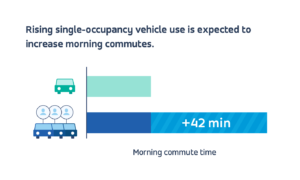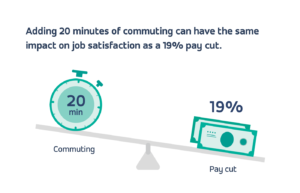The world’s biggest brands not only have an outsize influence on the global economy, they have a massive impact on the local communities where they are headquartered. Whether it’s the tech giants in Silicon Valley or Britain’s own large private corporations, like Boots in Nottingham, these companies dominate local employment and, as a result, create rising traffic congestion.
Part of this congestion is a byproduct of overreliance on single-occupancy cars, of course. But regional giants are realising that while they are not solely responsible for bad traffic and higher emissions, they can effect change in a meaningful way. In fact, they are exploring a variety of ways to make commuting easier on their employees and local traffic better for everyone, especially as employees begin commuting back to work. A new study from Vanderbilt University projects a dramatic rise in traffic across the United States caused by a rush to single-occupancy vehicles after the shutdown, specifically hitting the Bay Area the hardest. The trend could potentially increase morning commutes by up to 42 minutes.
 The driving force behind attempts to curb booming congestion is very simple: employees. To compete effectively, large corporates must make every effort to attract and retain top talent. That means keeping employees happy and productive. Bad commutes compromise both of these goals.
The driving force behind attempts to curb booming congestion is very simple: employees. To compete effectively, large corporates must make every effort to attract and retain top talent. That means keeping employees happy and productive. Bad commutes compromise both of these goals.
Plus, now there’s the added question of safety: how can employers help get their employees back to work safely? For some, that means helping reduce the exposure of their workforce to potential COVID-19 interactions during the daily commute. By taking commuting into their own hands – with the help of proven mobility technology – businesses can help their employees who already work together get safely to the office again, increasing productivity and satisfaction.

Bad congestion, worse outcomes.
Specifically, almost half of all employees say that commuting affects job satisfaction. That’s bad news for large employers when the average commuter in Cambridge, for instance, spends an extra week stuck in congestion compared to the second-most congested city in the UK. Here’s another way to think about it: adding 20 minutes of commuting can have the same impact on job satisfaction as a 19% pay cut.
Meanwhile, if employees are struggling through traffic to get to work, they have less time to focus on their responsibilities. They are more stressed when they arrive. Later on, they are burdened thinking about the intense commute home, with stressors from the morning drive reappearing the moment they get behind the wheel. Now throw in complications like rigid childcare pickup deadlines and some bad weather.
It’s a recipe for lost productivity and a growing desire to work closer to home — or in a different city with less traffic. While employers are now considering flexible working schedules and work-from-home options, they are also considering how to help employees get to work quickly and happily when they are needed in the office. And, if everyone drives a personal vehicle, the congestion will only get worse.

Pre-COVID, many companies added commuter perks to benefit packages. These include on- and offsite parking, subsidies for parking or public transport, and increased access to other transport options, such as bike sharing, ride sharing, rental cars, or car services. Some of these benefits are indeed attractive to new employees, but they are unlikely to make a sizable dent on local traffic. Other solutions are much grander in scale, such as corporate shuttles.
But what companies operating these shuttles are discovering, which municipalities already know, is that large-scale transport is extremely challenging to manage. It’s not the company’s primary area of expertise, so there is an ongoing learning curve, and ultimately it meets the needs of a relatively small percentage of employees who live a significant distance from the office.
How new corporate transport solutions can help.
In between the small perks and big bus fleets is a third option, known as demand-responsive transport. This approach combines the dynamic, demand-responsive scheduling of ride-sharing services with a dedicated fleet of passenger vans. Passengers can request pickup through an app and then a smart algorithm handles routing and dispatch, so multiple people can share the same trip while meeting safety requirements and appropriate social distancing.
DRT is appealing primarily because of its flexibility. The concept works with a small fleet of multi-passenger vehicles, making it relatively easy to scale and cost-effective. This approach is also less expensive to implement than a fleet of buses, which means it can be rolled out faster and make a more immediate impact on the company and on the city’s traffic congestion. It can also be used to supplement existing transport services in an ‘all of the above’ scenario, shuttling passengers who live very close to a head office, those who live far away, and those who need to connect to a public transport hub.
For employees, the benefits of a corporate transport service are obvious. The ability to leave your car at home and book a journey to and from work each day may seem like a luxury only afforded to the most elite executives. All employees can benefit from scrolling through morning emails during their daily commute, and demand-responsive pickup is a better fit for any employee who does not always work a strict 9 to 5. And as many companies know, a quick-hit solution with measurable impact not only reduces employee stress and improves their productivity. It also pays dividends with local community leaders focused on reducing traffic and congestion in their municipalities. Not to mention that companies might be more willing to explore this solution if they know they can also play a role in getting employees to and from work safely. In a new and unknown COVID era, social distancing measures and frequent, thorough vehicle cleanings must play a part in DRT services.
Needless to say, these days, providing a shared alternative for daily commutes has to be accompanied by measures that keep passengers and drivers safe. A demand-responsive corporate transport option that provides a safe and closed network, unique to a company and where technology is leveraged to enable contact tracing, can also help reduce the number of interactions between people while still achieving a huge array of benefits.
The daily grind of sitting behind the wheel stuck in traffic is a trope used by some of our favourite movies and TV shows, but it may not be for much longer. As companies realise the daily commute is often the worst part of their employees’ days, they’re incentivised to make some changes without needing to suddenly be experts in the transport business. By utilising similar technology to our favourite ride-hailing and food delivery apps, corporates can build a digital infrastructure for getting their employees to the office in more flexible, shared shuttles. If adding 20 minutes of commuting behind the wheel can have the same impact on job satisfaction as a 19% pay cut, imagine the impact of announcing that employees will never have to drive to work again.




